Home | Spreading Hope | Catholic Prayers, Beliefs & Prayer Line | Book Store
Sacramental Request | Volunteer Application | Donations | Scholarship |
Contact | Links| Facts About Abortion
![]()
|
A sacramental is a sacred sign that signifies effects
obtained through the Church's intercession. While the 7 Sacraments are
Christ-instituted and do exactly what they signify ex opere operato
("from the deed done"), sacramentals are Church-instituted and work chiefly
ex opere operantis, that is, through the pious disposition of the one
using them. When piously used, sacramentals remit venial sins.
Note: only a priest has the power to bless an object and make it a sacramental. Lay Catholics are free to bless objects, even using the prayers priests use -- and we do so often in blessing our children, blessing meals, blessing Advent wreaths or Mary Gardens, etc. -- but our blessing of something (or a person or an action) is a "mere" plea to God. Priests alone have been given the power to bless with a guarantee, as it were, and it is they and they alone who can take a new Crucifix or Rosary and turn them into sacramentals with the power of the entire Church behind them. |

|
Numbers 5:17 "And he shall take holy water in an earthen vessel, and he shall cast a little earth of the pavement of the tabernacle into it."
|
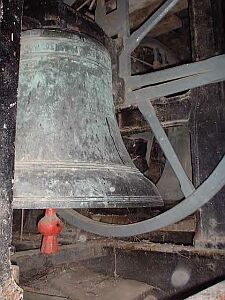
| When
Christians were still being persecuted by the Romans and overtly by Jews,
the only bells that could be used were small hand bells; but when Constantine
put a stop to the persecutions, larger bells came into general use.
Tradition (small "T") attributes Paulinus, Bishop of Nola, Campania, Italy,
with introducing them into Church use around the year 400, and St. Patrick
(A.D. 389-446) is said to have taken metalworkers to Ireland so they could
make bells for the churches he built there. These earlier bells weren't the
great cast bells we generally think of, but were hammered-iron bells, the
technology and/or materials for the former not being readily available out
in missionary lands. It wasn't until the 8th c. that the gorgeous cast bells
came to outnumber the less sonorous iron ones -- bells of great enough size
that bell towers began to be constructed just to house them. Over time, founders experimented with their bells' shapes and features to control for pitch and tone, and eventually devising various methods of ringing them. Where there were different types of bell in one church, each was used, alone or with others, for a different purpose -- one bell or stroke pattern to announce death, another to call the faithful to prayer, another to announce the grade of the Feast being celebrated, etc. They were used daily to announce the canonical hours and the Angelus. Descriptions of these various functions made their way onto the bells themselves, which were often inscribed with their name (see below) and/or a line of poetry signifying their use. Just one example:
|
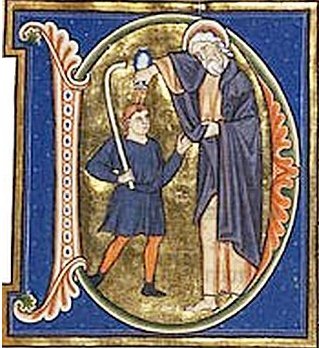
|
Exodus
30:22-25 "And the Lord spoke to Moses, Saying: Take spices, of principal and
chosen myrrh five hundred sicles, and of cinnamon half so much, that is, two
hundred and fifty sicles, of calamus in like manner two hundred and fifty.
And of cassia five hundred sicles by the weight of the sanctuary, of oil of
olives the measure hin: And thou shalt make the holy oil of unction, an
ointment compounded after the art of the perfumer..."
There are three kinds of
sacred oils, all of which signify the work of the Holy Spirit and symbolize
it in that oil "serves to sweeten, to strengthen, to render supple"
(Catholic Encyclopedia). The three holy oils are:
The blessing of oils is performed by the Bishop of each diocese on Maundy Thursday ("Holy Thursday") in the diocese's cathedral during a "Chrism Mass." The oils are kept in metal or glass bottles called "chrismatories," "chrismals," or "ampullae." These vessels are then stored in a cabinet called an "ambry," which is usually fixed to the wall of the sanctuary. Priests also have a portable "oilstock" which has a section for each of the three holy oils. Lay people are not to handle the holy oils, even to carry them, except in emergencies. |

|
Psalm 140:1-2 "I have cried to Thee, O Lord, hear me: hearken to my voice, when I cry to Thee. Let my prayer be directed as incense in Thy sight; the lifting up of my hands, as evening sacrifice."
... and its continued use was predicted, along with the Eucharistic offering, by Malachias:
Frankincense and myrrh were two of the three gifts the Magi brought to Baby Jesus:
-- and even the very angels in Heaven use incense, the smoke of which comes with the prayers of the Saints.
Incense is
used during the Mass to bless the Altar when the priest first ascends to it,
and, during the Offertory, to bless the bread and wine, the Crucifix and
Altar (again), and the congregation. Incense Use in the HomeThough stick
and cone incense may be used, the classic way of using incense at your
family altar is to use resin incense (like the priests use), which comes in
large "grains," in a charcoal incense burner. Simply place a piece of
charcoal in the burner, light it until it is glowing (it might spark at
first), and place about a 1/2 a teaspoon or so of incense on top (not so
much that the charcoal will be smothered). It is good to have a supply of
those bamboo sticks that are used in making shishkabobs: they come in handy
for lighting not only charcoal inside the burner, but for lighting tall
pillar candles that've burned down deeply inside their glass holders. |
| God became man. The "earthy" reality of the Incarnation is probably one of the main concepts the focusing on which separates Catholics (and Orthodox) from most other Christians. Adherents to more Puritanical forms of Christianity are scandalized by images; seeing a Corpus on a Crucifix instead of an empty Cross, seeing churches adorned with statues and other icons, etc. seem so -- "undivine" or "wordly" to these people; but we Catholics know that Christ, by taking on flesh and becoming man, redeemed us and gave to us the offer of a dignity which, without Him, would be impossible. It is to always be remembered that we are not souls trapped in flesh, but enfleshed souls who are called to use our bodies and time on earth glorifying Him and, in consequence, becoming divinized and sharing in His Divine Nature. Our time in this material world isn't some kind of cruel joke. All Truth, all Beauty, all Goodness point to Him, amen, and the beautiful and good things of this world are a shadow of the world to come. Our statues and other icons help us to see this as they also inspire us to meditate on the specific divine realities they mean to convey. When Christ incarnated at the Annunciation and was born of the Virgin nine months later, He demonstrated one of the first Biblical Truths: what God made is good, and flesh, while humbling for God to take on, while weak, and while prone to corruption and sin after the Fall, is not inherently evil. Christian understanding of the consequences of this reality is evident from the beginning, as far back as the Catacombs, and two-dimensional painted icons, statues, and mosaics have always been used as aids to Christian worship. Nonetheless, during the 8th c., two great waves of iconoclasm struck Christianity in the East, the first led by Emperor Leo III who was influenced by the success of iconoclastic Islam and a revival of the Monophysite heresy which denied Christ's humanity. Pope Gregory II denounced Leo and his iconoclastic movement, and the Seventh Ecumenical Council at Nicaea (A.D. 787) firmly explained the difference between idolatry and the veneration given to icons. Pope St. Gregory the Great explained this difference and extolled images' catechetical value in a letter he wrote to an iconoclast Bishop:
Icon writer, Leontius the Hierapolian, wrote about the Christian use of images:
Nonetheless,
the iconoclasts raged on in the East, and Christians there begged the Pope
to intervene, with St. Theodoret writing, "Whatever novelty is brought into
the Church by those who wander from the truth must certainly be referred to
Peter or to his successor . . . . Save us, chief pastor of the Church under
heaven" and "Arrange that a decision be received from old Rome as the custom
has been handed down from the beginning by the tradition of our fathers."
2-D IconsThough the
word "icon" (also "ikon" or "eikon") refers to religious images of any sort
-- 2-D, 3-D, made of any material, in this section, I will use the word to
refer specifically to two-dimensional representations which have become
highly stylized over time and which one typically associates with the word
"icon." Like all religious images, an icon has as its purpose acting as a
"window to Heaven," a portal through which one sees greater Truths than can
be revealed by word alone.
Symbology in Icons
Reading IconsLet's take a
look at the icon of Our Lady of Perpetual Help (also called "Our Mother of
Perpetual Help" and "Virgin of the Passion") to get an idea of how to read
icons. But first, a little history, because the story of this icon is so
interesting.
Below are descriptions and pictures of some of the most famous icon types. You will see the same artistic elements and schemes in icons from different eras and ritual Churches, in different styles, but with recurring themes and standardized types. The icons below can be purchased from Skete Icons.
|
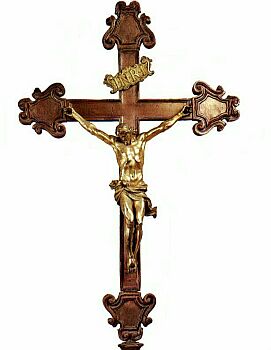
|
I Corinthians 1:23-24 "But we preach Christ crucified: unto the Jews indeed a stumblingblock, and unto the Gentiles foolishness: But unto them that are called, both Jews and Greeks, Christ, the power of God and the wisdom of God."
|
| Whoever carries on his person the Pardon Crucifix, may thereby gain an indulgence. | |
| For devoutly kissing the Crucifix, an indulgence is gained. | |
| Whoever says one of the following invocations before this crucifix may gain each time an indulgence: "Our Father who art in heaven, forgive us our trespasses as we forgive those who trespass against us." "I beg the Blessed Virgin Mary to pray to the Lord our God for me." | |
| Whoever, habitually devout to this Crucifix, will fulfill the necessary conditions of Confession and Holy Communion, may gain a Plenary Indulgence on the following feasts: On the feasts of the Five Wounds of our Lord, the Invention of the Holy Cross, the Exaltation of the Holy Cross, the Immaculate Conception, and the Seven Dolors of the Blessed Virgin Mary. | |
| Whoever at the moment of death, fortified with the Sacraments of the Church, or contrite of heart, in the supposition of being unable to receive them, will kiss this Crucifix and ask pardon of God for his sins, and pardon his neighbour, will gain a Plenary Indulgence. |
And there is this: Pontifical Rescript of June 1905, to M.M. the Abbes Lemann:
Prefect of the Sacred Congregation of Indulgences
To the faithful, who devoutly kiss this Crucifix and gain these precious indulgences, we recommend to have in view the following intentions: To testify love for Our Lord and the Blessed Virgin; gratitude towards our Holy Father, the Pope, to beg for the remission of one's sins; the deliverance of the souls in Purgatory; the return of the nations to the Faith; forgiveness among Christians; reconciliation among members of the Catholic Church. By another Pontifical rescript of November 14 1905. His Holiness Pope Pius X, has declared that the Indulgence attached to the Pardon Crucifix are applicable to the souls in Purgatory.
On the back of the Crucifix, on the transverse arms, are the words, "Father, forgive them." On the long part of the Cross are the words, "Behold this heart which has so loved men." The Sacred Heart is shown where the two arms of the Cross meet.
Caravaca Cross or Crucifix
(a.k.a. "Cara Vaca" and "Cuernavaca")
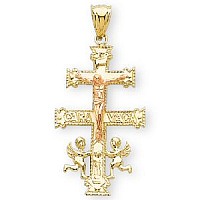
This Cross takes its name from Caravaca (now known as Caravaca de la Cruz),
Spain, a town in the province of Murcia where, in A.D. 1231, a priest was
imprisoned by the Moors. Out of curiosity, his captors' King, Abu Zeid,
asked him to say Mass, but as the priest began, he realized he didn't have
the necessary Crucifix. As his captors grew angry, the Patriarch of
Jerusalem's pectoral cross was transported to the priest through an open
window, borne by two angels. Seeing this, King Abu Zeid converted to the
true religion.
The "Caravaca Cross," then, is the two-armed Lorraine Cross that is used by
Archbishops and Patriarchs. Some representations are Crucifixes, such as the
one above, and may show the angels that carried the Cross, one on each side.
The words "Caravaca" may appear on the second arm of the Cross such that
"Cara" is on one side, and "vaca" on the other. This is a very popular
Crucifix in Spain and Mexico.
![]()
Read also about the St. Benedict Medal for information on the Crucifixes
with the St. Benedict Medal embedded -- a most powerful sacramental. See,
too, see the page on Christian Symbols for the shapes of other types of
Crucifixes (and Crosses)

Palms are sacramentals of the Church distributed to the faithful on Palm Sunday (the Sunday before Easter) -- the day that commemorates Christ's entry into Jerusalem. Their purpose is to honor Christ's glory and Kingship, as did the inhabitants of Jerusalem who met Him, strewing palm branches on the street before Him. Carrying palms in procession goes way back into the Old Testament, where it was not only approved but commanded by God at the very foundation of the Old Testament religion. In the fall of the year, after the harvest, when the people gathered for the Feast of Tabernacles God said in Leviticus 23:40:
Again we read of palms in the II Machabees 10:6-8:
And in the 7th chapter of the Apocalypse, we see that those who were "sealed" are seen by John carrying palms:
The palms are blessed before the High Mass on Palm Sunday. Vested in red cope and standing at the Epistle side of the Altar, the priest recites a short prayer, and then reads a lesson from the book of Exodus which tells of the children of Israel coming to Elim on their way to the Promised Land, where they found a fountain and seventy palm trees. It was at Elim that God sent them manna.
After a few verses from the New Testament, the priest reads the story of
Christ's triumphal entry into Jerusalem the Sunday before His death, and
about how the people put palms in the Savior's path and sang hosannas
because, ironically, they expected a temporal victory by the One they
thought would be the great military leader who would conquer the Romans..
|
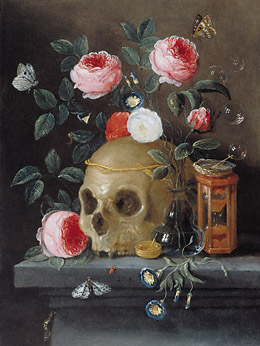
Ecclesiasticus 7:40 "In all thy works remember thy last end, and thou shalt never sin."
| In the 17th. c., a style of painting known as "vanitas painting" became popular (see above). This style included elements that represented temporal bounty - flowers, fruits, etc., and symbols of riches, such as gold and jewels. These gorgeous gifts from God were then juxtaposed with symbols that showed the reality of death, usually a skull, or an hourglasses that symbolized the passage of time. The point of this style is the moral of which Ecclesiasticus 1 reminds us, "What profit hath a man of all his labour which he taketh under the sun? One generation passeth away, and another generation cometh..." In other words, the things of this world are transient, and Christians must always keep one eye on the world to come. Recalling this Truth is one of the principles behind the use of ashes on the forehead on Ash Wednesday, the first day of the Lenten Season of penance: to remind us that we are mortal, subject to the rot and decay our Western culture now desperately tries to euphemize away, and that we are radically dependent on -- solely dependent on -- Jesus Christ to overcome this fate. They are like a yearly reading of the tombstone inscribed with:
They are a
liturgical "memento mori."
|
|
4 Kings 2:19-22 "And the men of the city, said to Eliseus . Behold the situation of this city is very good, as thou, my lord, seest: but the waters are very bad, and the ground barren. And he said: Bring me a new vessel, and put salt into it. And when they had brought it, He went out to the spring of the waters, and cast the salt into it, and said: Thus saith the Lord: I have healed these waters, and there shall be no more in them death or barrenness. And the waters were healed unto this day, according to the word of Eliseus, which he spoke."
|
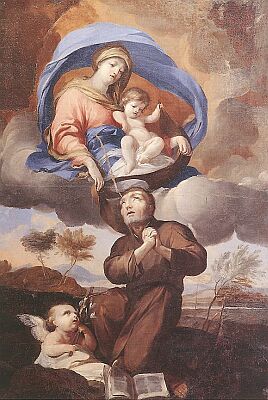
| A scapular is a sacramental that looks like two small pieces of wool cloth connected by string that is worn over the neck, either under or over one's clothing, such that one piece of cloth hangs over the chest, and the second piece of cloth hangs over the back (see picture below). They derive from the scapulars which make up part of monastics' religious habits -- that ankle-length (front and back), shoulder-wide, apron-like part of the habit that basically consists of a long rectangular piece of material with a hole for the head (some of them have hoods and some had ties under the arms). Monastic scapulars came, over time, to be called jugum Christi (the yoke of Christ), and receiving the scapular (becoming "invested") took on solemn meaning. Abbreviated forms of the full monastic scapulars were to be worn even at night.
|
|
Brown
Scapular "The Brown
Scapular of our Lady of Mount Carmel," associated with the Carmelite Order,
is the most well-known. In A.D. 16 July 1251, Our Lady appeared to St. Simon
Stock in Cambridge, England after he prayed for help for his Order. She
appeared to him with the scapular and said, "Take, beloved son this scapular
of thy order as a badge of my confraternity and for thee and all Carmelites
a special sign of grace; whoever dies in this garment, will not suffer
everlasting fire. It is the sign of salvation, a safeguard in dangers, a
pledge of peace and of the covenant."
You can be
enrolled in the Confraternity of our Lady of Mount Carmel by any priest.
Just obtain a scapular, take it to him to have it blessed, and express your
desire for enrollment. |
||||||||
|
Blue
Scapular "The Blue
Scapular of the Immaculate Conception" originated with the foundress of the
Theatine Order of nuns, Venerable Ursula Benicasa. To her, Christ promised
favor to that Order and she asked Him to extend those promises to those who
associated themselves with the Order through the faithful wearing of the
Scapular. The Blue Scapular is worn for the conversion of sinners. |
||||||||
|
Red
Scapular "The Red
Scapular of the Passion" came about when a Sister of Charity of St. Vincent
de Paul had a vision of Christ in 1846 in which He promised an increase in
the theological virtues (Faith, Hope, and Charity) of those who wore the
scapular faithfully and contemplated His Passion. One side of the scapular
shows Christ on the Cross, with the words, ""Holy Passion of Our Lord Jesus
Christ Save us"; the other side shows the Sacred Heart of Jesus and the
Immaculate Heart of His mother with the words, "Sacred Hearts of Jesus and
Mary, protect us." |
||||||||
|
Black
Scapular "The Black
Scapular of the Seven Dolors of Mary," or "The Our Lady of Sorrows
Scapular," has on its front a depiction of Our Lady of Sorrows. Our Lady
appeared to seven rich and prominent citizens of Florence who decided to
give up their worldly possessions and follow Christ, promising to honor His
Mother in her sorrows. Thus began the Servite Order. Mary gave them the
Servite habit and said that "these garments shall be to you a perpetual
memory of the sufferings of my heart." This is the more common Black
Scapular. |
||||||||
|
Black
Scapular St. Paul of
the Cross, before founding the Congregation of the Passionists, received in
apparitions the black habit of the order with the badge on the breast.
Later, after the foundation of the congregation, the Passionist Fathers gave
the faithful who wished to associate themselves more closely with their
order a black scapular in honour of the Passion of Christ. "The Black
Scapular of the Passion" has a replica of the emblem worn on the habits of
the Passionists. It includes the words "Jesu XPI Passio" and below "sit
semper in cordibus nostris." |
||||||||
|
White
Scapular "The Scapular
of the Most Blessed Trinity" is the badge of the members of the
Confraternity of The Most Blessed Trinity. Its front depicts a red and blue
Cross, and it first came about in 1198 when a Spanish priest, John of Matha,
had a vision of an angel wearing a white robe adorned with a Cross whose
vertical line was red and whose cross-beam was blue (this Cross design came
to be on the habit of the Trinitarian Order). This Scapular was first used
for the purposes of of increasing action to "ransom the captives" -- the
Christians taken prisoner by Muslims. |
||||||||
|
Green
Scapular In 1840, Mary appeared to Sister Justine Bisqueyburu (a Seminary Sister of the Daughters of Charity) in Paris, France and commended the Green Scapular to her. It's known as "the Scapular of Conversion," and its promises are the strengthening of faith, protection against Satan, a happy death for Catholics, and, most of all, for conversion for those outside the Church. It's to be worn or carried by the faithful, or given to an unbeliever for their conversion. The following prayer is to be said daily by the wearer:
If the scapular is given to an unbeliever for their conversion, the person giving the scapular prays the prayer for them if the unbeliever does not want to pray the prayer himself. If the unbeliever does not want the scapular, it may be hidden in their vicinity and the prayers said for him. Enrollment in a Confraternity is not necessary for this scapular. |
||||||||
|
Scapular
of St. Joseph A gold and
violet-colored scapular with a white cord, the front shows St. Joseph
holding the child Jesus in one arm and a staff of lillies on the other.
Underneath are the words, "St. Joseph, patron of the Church, pray for us."
On the back of the scapular are the papal crown under a dove as the symbol
of the Holy Ghost. Underneath those are the Cross, the keys of Peter, and
the inscription: "Spiritus Domini ductor eius" (The Spirit of the Lord is
his Guide). |
||||||||
|
The Five-Fold Scapular is made of 5 of the following Scapulars above: first, the "The Red Scapular of the Passion," then the "The Scapular of the Most Blessed Trinity," the "The Brown Scapular of our Lady of Mount Carmel," the "The Black Scapular of the Seven Dolors of Mary," and the The Blue Scapular of the Immaculate Conception." Any priest can invest you with this scapular. |
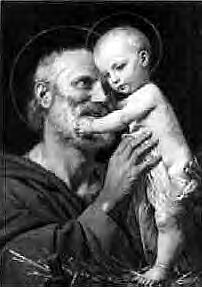
|
Luke 12:34-35
"For where your treasure is, there will your heart be also. Let your loins
be girt and lamps burning in your hands." The cincture,
like the one priests wear at Mass, is a sign of chastity, and has been since
the Church's beginning -- and before. Old Testament priests wore cinctures,
consecrated Virgins and religious wear cinctures, and the wearing of
cinctures in honor of a particular Saint is ancient, first spoken of in the
life of St. Monica, the mother of St. Augustine, and carried on by St.
Dominic, who wore a cincture in honor of St. Francis. Certain
Confraternities and Archconfraternities (groups of faithful devoted to a
religious cause) also wear cinctures as signs of their affiliation and
chastity. The Cord of St. Joseph was approved by the Sacred Congregation of Rites, 1859, and enriched by Pope Pius IX with many indulgences, both plenary and partial. It is made of white thread or cottons, having at one end seven knots in remembrance of the Seven Joys and Seven Sorrows of St. Joseph. The
devotion of wearing this cincture spread, and soon became associated with
the Archconfraternity of St. Joseph, whose headquarters were at the
Church of San Rocco in Rome. The American "branch" of this Archconfraternity,
by decree of Pope Leo XIII in 1892, is at St. Joseph's Church in De Pere,
Wisconsin, which was staffed by the Norbertines. In order to gain the
indulgences attached to the wearing of St. Joseph's Cord, one must be
attached to this Archconfraternity of St. Joseph.
Young people,
especially, would benefit from St. Joseph's Cincture! We need to be reminded
of the importance of chastity, especially now, when sexual decadence is all
around us.
If your St.
Joseph's Cord comes with only two knots, one at each end, then you should
tie the other 5 into it. When you get your Cord, it must be blessed by a
priest (see below), and then worn around the waist. One who wears the St.
Joseph's Cord is to daily say a Gloria on each of the 7 knots, in honor of
and while meditating on each of the 7 Sorrows of St. Joseph, and a prayer to
St. Joseph for purity. These prayers are: Prayer to St. Joseph for Purity to be said by the wearers of the Cord of St. Joseph Guardian of virgins, and holy father Joseph, to whose faithful custody Christ Jesus, Innocence itself, and Mary, Virgin of virgins, were committed; I pray and beseech thee, by these dear pledges, Jesus and Mary, that, being preserved from all uncleanness, I may with spotless mind, pure heart, and chaste body, ever serve Jesus and Mary most chastely all the days of my life. Amen. (100 days indulgence, once a day) Recite this prayer each day, adding thereto, seven times, Gloria Patri (Glory Be) Gloria Glory be to the Father, and to the Son, and to the Holy Ghost. As it was in the beginning, is now, and ever shall be, world without end. Amen. (A plenary indulgence, is gained on the first day the cord is put on. On the the principal Feast of Our Lord and Our Blessed Virgin, on the Feast of St. Joseph and on any of the seven following days those wearing the Cord may also obtain a Plenary Indulgence. For every day the cord is worn a Partial Indulgence of 60 days may be gained.) Invocation to St. Joseph Good St. Joseph, our guide, protect us, protect the Holy Church
(50 days indulgence, each time- Pope Pius IX,. Jan.
27, 1863.) Optionally,
to increase one's devotion to the Blessed Spouse, one may meditate on the
Seven Sorrows and Joys of St. Joseph with the following prayers:
Priest's
Blessing of a Cincture
|
|||||||||||||||||||||||||||||||||||||||||||||||||||||||||||||||||||||||||||||||||||||

The medal of St. Benedict is a very powerful sacramental with exorcizing properties; the exorcism is written right on it. First a little history: St. Benedict of Nursia, Italy (A.D. 480-543), the twin brother of St. Scholastica, is considered to be the Father of Western monasticism, and his "Rule of St. Benedict" came to be the basis of organization for many religious orders (his own Order has its cradle at Monte Cassino, Italy, about 80 miles South of Rome). At any rate, in order to understand the symbology of the Medal, you must know of this event in St. Benedict's life: he'd been living as a hermit in a cave for three years, famous for his holiness, when a religious community came to him after the death of their abbot and asked Benedict to take over. Some of the "monks" didn't like this plan and attempted to kill him with poisoned bread and wine. Just as St. John the Divine was miraculously saved from being poisoned, when St. Benedict made the sign of the Cross over these things, the cup holding the wine shattered, and a raven carried off the bread. Now on to the Medal: From the Catholic Encyclopedia:
The Jubilee
Medal below was first struck in 1880 to commemorate the 14th centennary of
St. Benedict's birth. The Front of the Medal
|
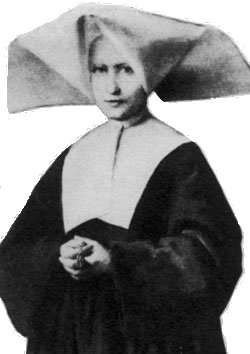
On the night of 18
July, 1830, a "child" awakened Sr. Catherine Labouré (seen above) in her
Sisters of Charity convent at 140 Rue du Bac, Paris, telling her to go to
the convent's chapel where Mary awaited her. There Mary told her:
Later that year, on 27 November, Catherine saw another vision of Mary. She describes her like this:
Mary told her that the
globe represented the whole world, especially France, a country whose
faithful had recently suffered horrible persecutions in the Revolution's
Terrors and was still going through "Enlightenment" perfidy.
Sr.
Catherine's spiritual director told Catherine's story to the Bishop of
Paris, who not only allowed the medal to be struck, but received some of
them himself. One of these he had with him when ministering to Napoleon's
dying, heretical chaplain. The dying man had obstinately refused to
reconcile with the Church, but as the Bishop was leaving after trying one
last time to get him to see the error of his ways, the man suddenly broke
down and repented. The Bishop attributed this to the Virgin's intercessions
through the medal. |
Medieval Reliquary
|
4 Kings
13:20-21 "And Eliseus died, and they buried him. And the rovers from Moab
came into the land the same year. And some that were burying a man, saw the
rovers, and cast the body into the sepulchre of Eliseus. And when it had
touched the bones of Eliseus, the man came to life and stood upon his feet."
St. Jerome clarified Catholic belief in his Ad Riparium:
When considering relics, it is to be remembered that the body and soul are forever one, even when they seem to be separated by death. The body of the saved will be resurrected and glorified (the bodies of the damned will also be resurrected, for that matter). Forever is there a connection between the remains and the soul that has departed from them -- and the great souls whose remains are left to us have a power described well by St. John of Damascus (a.k.a. "John Damascene"), ca. A.D. 676 - 754/87, in his "Exposition of the Orthodox Faith":
Classes of Relics
|
|||||||||
|
1st Class Relic: |
a part of the Saint (bone, hair, etc.) and the instruments of Christ's passion |
|
2nd Class Relic: |
something owned by the Saint or instruments of torture used against a martyr |
|
3rd Class Relic: |
something that has been touched to a 1st or 2nd Class Relic. You can make your own 3rd Class relics by touching an object to a 1st or 2nd Class Relic, including the tomb of a Saint. |
Relics in churches or chapels are usually kept in one of two places: in a cavity ("sepulchre") inside the Altar or in a "reliquary." Reliquaries have taken on a variety of shapes -- boxes, Noah's Arks, caskets, the shape of an arm, leg, head, etc.. -- and some are exquisite specimens of gold and silversmithing.
Canon Law
1190
§1 It is absolutely wrong to sell sacred relics.
§2 Distinguished relics, and others which are held in great veneration by
the people, may not validly be in any way alienated nor transferred on a
permanent basis, without the permission of the Apostolic See.
While selling relics ("simony") is wrong, it is permissible to buy
them if they will be marketed anyway and buying them would
save them from desecration. This must be done only if the good that comes
from buying the relic outweighs other uses the money spent could be used for
-- and this should never be done at auction because bidding would only drive
up the price, forcing others who simply want to rescue relics to pay more.
This could also increase the likelihood of a market developing in the sale
of relics.
Relics may be legitimately obtained from Church sources, i.e., the Vicariate
in Rome, the religious Order of the Saint involved, the shrine of the Saint
involved, etc. When this is done, a donation is usually expected to cover
the cost of the metal container (theca) that contains the relic, but
in any case, a profit cannot legitimately be made from the sale of relics by
anyone.
Particular Relics
| I
thought I'd list the locations of some of the major first class relics
here so that you'll know where to find them if you're blessed to make a
pilgrimage to these locations. The sites below house the greatest part
of the given relic, but tinier pieces may be found throughout the world,
especially in the Altars of Catholic churches. Note that some of the Saints are marked as "incorrupt"; this refers to the phenomenon whereby some Saints' bodies do not corrupt after death. An example is St. Bernadette Soubirous, who saw Our Lady at Lourdes and who now lies in a glass coffin at her convent in Nevers, France. Though she died in A.D. 1879, she is as lovely as she ever was (first picture at right. For a larger view, click on it; the larger picture will open in a new browser window). Other examples are those of Blessed Imelda Lambertini, who died in ecstasy during her First Communion in A.D. 1333 at age 11; of St. Catherine Labouré, who had the vision of Our Lady which led to the minting of the Miraculous Medal and who died in A.D. 1876; of St. Maria Mazzarello, the first Salesian Sister, who died in A.D. 1881; and of St. John Vianney, Curé d'Ars, who died in A.D. 1859 (see pictures at right). There are many more. This phenomenon of incorruptibility is often accompanied by a sweet fragrance, known as the "odor of sanctity," which has been described as being unlike any known perfume. Another related phehomenon is the flow of a healing liquid, called "oil of saints," which exudes from the Saint's body or tomb. In the case of some Saints who exude this "oil," the flow of liquid is periodic and not constant (the famous flow of "oil" from the relics of St. Walburga, who is not incorrupt, is periodic like this). No one knows why some Saints are preserved from corruption while others aren't, and incorruptibility is never seen, in itself and by itself, as a proof of holiness. It is a good indicator of such when the deceased was known for his life of faith and virtue -- but it's a phenomenon that can be mimicked by science, by the effects of natural conditions, and by the demonic. |
|
Austria
Relic:
St. Longinus' Lance (lance of the Roman soldier who
pierced Christ's side)
Where: Hofburg Treasure House, Vienna, Austria. The shaft of the
lance is at St. Peter's Basilica, Rome.
Relic: St. Elizabeth of Hungary
Where: Convent of St. Elizabeth, Vienna, Austria. Preserved here is
St. Elizabeth's skull, crowned with the crown she wore in life.
Belgium
Relic:
St. Dymphna
Where: Church of St. Dymphna, Gheel (province of Antwerp), Belgium
Canada
Relic: Kateri Tekakwitha (awaiting canonization)
Where: Saint Francis-Xavier Mission Church, Kahnawake, Quebec, Canada
Relic: St. Isaac Jogues, St. Jean de Brébeuf, and Companions
Where: The Martyrs' Shrine, Highway 12, Midland, Ontario, Canada
Relic:
St. Anne
Where: Church of Ste. Anne de Beaupré, Ste. Anne de Beaupré,
Montmorency county, Quebec, Canada (the majority of St. Anne's relics are in
Apt, Bouches-du-Rhone, Provence, France).
Czech Republic
Relic: St. Wenceslaus, St. Vitus
Where: Cathedral of St. Vitus, Prague, Czech Republic
Relic:
St. Ludmilla
Where: St. George's Basilica, Prague, Czech Republic
Note:
Though not a shrine in honor of canonized Saints, also of note in the Czech
Republic is "Sedlec Ossuary" ("Kostnice") of the Cistercian All Saints
chapel in Sedlec, a suburb on the outskirts of the town of Kutna Hora, about
45 miles East of Prague. In A.D. 1278, the abbot there went on a pilgrimage
to the Holy Land and brought back some soil, which he poured over the
cemetery ground. Christians, then, wanted to be buried in that soil when
they died, but after a time the graveyard became too crowded, especially in
A.D. 1318, when 30,000 people were buried after dying from the Plague. An
ossuary was built so that the older bones could be dug up and new bodies
buried. A woodcarver was later hired to decorate the chapel, and he used the
bones decoratively. The ossuary came to be adorned -- literally -- with the
bones of around 40,000 Christians.
Ecuador
Relic: Mother Mariana de Jesus Torres (incorrupt), and the
miraculous image of Our Lady of Good Success
Where: Mother Mariana lies in a glass coffin at the cloistered
Convent of the Immaculate Conception in Quito, Ecuador. The miraculous
statue can be seen by the public at these times: during the novena
anticipating the Feast of the Purification, from around January 24 to
February 2; during the month of May; during the month of October.
Egypt
Relic:
St. Mark, Evangelist
Where: St. Mark Church in Alexandria, Egypt. (Cenotaph in Church of
San Marco Venice, Italy where his relics had been taken during the
Crusades.)
England
Relic: The Venerable Bede
Where: Galilee Chapel, England
Relic: St. Edward the Confessor (incorrupt)
Where: Westminster Abbey, London, England
Relic: St. John Southworth
Where: Westminster Cathedral (Precious Blood Cathedral), London,
England. St John was hanged, drawn, and quartered during the Protestant
"Reformation" for celebrating the Traditional Mass. The quarters of his body
and his head were recovered after the execution, reassembled and sent to the
Catholic Seminary at Douai, where it was buried during the Napoleonic purges
in France. The relic was re-discovered in the last century during
construction work to build a new road, and is now contained within a silver
effigy, dressed in red Mass Vestments and contained within a glass reliquary
in the Chapel of Saint George and the English Martyrs.
Relic: St. Thomas More and St. John Fisher
Where: Church of St. Peter ad Vincula in the Tower of London (St.
Thomas More's head, after it was removed, was boiled and displayed, after
which it was to be thrown into the Thames River. His daughter rescued it by
bribing the guard and allegedly buried it in her husband's family vault).
France
Relic: St. Francis de Sales
Where: Church of the first Monastery of the Visitation, Annecy,
France (his incorrupt heart is preserved at the Monastery of the Visitation,
Treviso, Italy).
Relic: St. John Vianney (incorrupt)
Where: Basilica at Ars, France
Relic: St. Simon Stock
Where: Carmelite monastery, Bordeaux, France (his skull is preserved
at Aylesford, Kent, England).
Relic: St. Thérèse of Lisieux
Where: Chapel of the Convent of Carmel, Lisieux, France
Relic: St. Bernadatte (incorrupt)
Where: Convent of St. Gildard in Nevers, France
Relic: St. Margaret Mary Alacoque (unsure as to whether or not she is
incorrupt; I've read that her relics are not incorrupt, but are kept in a
figurine of her which makes her appear incorrupt)
Where: Shrine of St. Margaret Mary Alacoque, Paray-le-Monial, France
Relic: St. Genevieve
Where: Saint Etienne-Du-Mont, Paris, France
Relic: Crown of Thorns and a piece of the True Cross
Where: Kept, starting with King St. Louis IX, at Ste. Chapelle,
Paris, France (on the Ile de la Cité, near Notre Dame) -- a chapel the
sainted King built just for these relics. Removed during the French
Revolution and placed in the Bibliotheque Nationale. They are now at Notre
Dame Cathedral in Paris (but visit Ste. Chapelle anyway! It is stunning...).
Relic: St. Catherine Labouré (incorrupt)
Where: Chapel of the Sisters of Charity Convent, 140 Rue du Bac,
Paris, France
Relic: St. Vincent de Paul (incorrupt)
Where: Church of St. Vincent de Paul, Rue de Sevres, Paris, France
(his heart is at the Chapel of the Miraculous Medal)
Relic: St. Fiacre
Where: Cathedrale de Meaux, Seine et Marne, France
Relic: St. Thomas Aquinas
Where: Basilica of St. Sernin, Toulouse, France
Relic: St. Vincent Ferrer
Where: Cathedral of Vannes, Vannes, France
Germany
Relic:
The Three Magi
Where: Discovered in Persia, brought to Constantinople by St. Helena,
transferred to Milan in the fifth century and then to the Cathedral of
Cologne, Germany in A.D. 1163, where they've been ever since.
Relic: St. Ursula
Where: Ursalaplatz (Church of St. Ursula), Cologne, Germany
Relic: St. Albert the Great
Where: Komdienstraße (Church of Saint Andreas), Cologne, Germany
Relic: St. Hildegaard von Bingen
Where: Parish church of Eibergen, Eibergen, Germany (originally
buried at the graveyard of the convent of Disibodenberg. Translated to
present location in A.D. 1642).
Relic:
St. Walburga
Where: Church of St. Walburga, Eichstätt, Bavaria, Germany. Her
relics exude a healing "oil of Saints" between 12 October and 25 February,
her Feast in the Benedictine Breviary.
Relic: St. Boniface
Where: Cathedral of Fulda, Fulda, Germany
Relic: St. Mundita
Where: Peterskirche (St. Peter's Church), Rindermarkt 1 (near the
Rathaus), Munich, Germany. I have no idea who this Saint it, but her
skeleton is gilded, bejeweled, and kept in a glass case. Fitted with glass
eyes, she seems to stare at you from the beyond...
India
Relic:
St. Francis Xavier
Where: Basilica Bom Jesus, Goa, India
Italy
Relic:
St. Andrew, Apostle
Where: Cathedral of Amalfi, Italy
Relic: St. Bernardine of Siena
Where: Basilica di S.Bernardino, Aquila, Abruzzo, Italy
Relic: St. Francis of Assisi
Where: Lower Church of the Basilica of Saint Francis of Assisi,
Assisi, Umbria, Italy
Relic: St. Clare of Assisi, St. Agnes of Assis, and their mother,
Blessed Ortolana
Where: Basilica of Santa Chiara, Assisi, Umbria, Italy
Relic: St. Nicholas of Myra
Where: Translated from Myra to the Church of St. Stephen in Bari,
Apulia, Italy in A.D. 1087 to save them from Muslim desecration.
Relic: St. Dominic
Where: Church of St. Dominic, Bologna, Italy
Relic: Blessed Imelda Lambertini (incorrupt)
Where: San Sigismondo Church near the University of Bologna, Bologna,
Italy
Relic: St. Rita of Cascia (incorrupt)
Where: Basilica of St Rita in Cascia, Italy
Relic: St. Gerard Majella
Where: Caposele, Italy
Relic: Eucharist whose accidents had turned also to Flesh in A.D. 700
Where: Church of Lagontial, Lanciano, Italy
Relic: St. Ambrose
Where: Basilica of Sant'Ambrogio, Milan, Italy (crypt open on his
Feast Day)
Relic: St. Charles Borromeo
Where: Cathedral of Milan, Italy
Relic: St. Veronica's Veil (?)
Where: Carthusian Monastery, Monoppello, Italy. If this is the true
Veil of Vernoica, the history goes like this: the veil had been kept at St.
Peter's Basilica, Rome, Italy (there is a niche for it near the statue of
St. Veronica there), but was removed from there when St. Peter's was being
rebuilt, and taken to this monastery in A.D. 1608. There is either a copy of
the veil at the Vatican today in the aforementioned niche, or the one at the
Vatican is the original (all other copies of the Veil were prohibited by
Pope Paul V in 1616).
Relic: St. Januarius (Genarro)
Where: Cathedral of Naples, Naples, Campania, Italy. A vial of St.
Genarro's dried blood liquefies and "boils" when brought near his head 18
times a year.
Relic: St. Benedict and St. Scholastica
Where: Abbey of Monte Cassino, on a hill overlooking Monte Cassino,
Italy
Relic: St. Maria Goretti
Where: Our Lady of Grace, Nettuno, Italy
Relic: St. Anthony of Padua
Where: Basilica of St. Anthony, Padua, Italy. When St. Anthony's
coffin was opened 30 years after his disposition, most of his body was found
to have returned to dust but for his tongue, which remained fresh as a sign
of his gift of preaching. It is this that is kept at the Basilica.
Relic: St. Augustine
Where: San Pietro in Ciel D'Oro, in Pavia, Italy
Relic: St. Barbara
Where: Cathedral of Rieti, Italy
Relic: Titulus Crucis, a Crucifixion nail, relic of the True Cross,
two thorns from the Crown of Thorns, the greater part of the sponge used to
give Christ vinegar, a piece of the good thief's cross
Where: Santa Croce in Gerusalemme (Holy Cross in Jerusalem) 12 Piazza
di Santa Croce in Gerusalemme, Rome, Italy. The church, whose floor was
packed with soil from the Holy Land, was consecrated about A.D. 325, in an
older building that was rebuilt to house the Passion Relics brought to Rome
by St. Helena, Constantine's mother. The "Titulus Crucis" is the sign that
hung over Christ's Head, naming Him as "King of the Jews."
Relic: St. Agnes
Where: Sant' Agnese fuori le mura (St Agnes Outside the Walls), 364
Via Nomentana, Rome, Italy. The church is built over St. Agnes's tomb. Her
head is preserved at the Sancta Sanctorum in the area.
Relic: Many Popes, including: St. Peter; St. Leo the Great; St.
Gregory the Great; St. Pius X (incorrupt). Many Saints, including St.
Gregory Nazianzen.
Where: San Pietro in Vaticano (St. Peter's Basilica, Vatican City,
Italy)
Relic: St. Jerome and St. Pius V (incorrupt)
Where: Santa Maria Maggiora (St. Mary Major) 42 Piazza di Santa Maria
Maggiore, Rome, Italy
Relic: St. Bartholomew, Apostle (?)
Where: St. Bartholomew-in-the-Island, Rome, Italy
Relic: St. Lawrence and St. Stephen
Where: San Lorenzo fuori le Mura (St Lawrence outside the Walls,
a.k.a. San Lorenzo in Campo Verano) 3 Piazzale del Verano, Rome, Italy. The
church is built over the tomb of St. Lawrence. St. Stephen was brought from
Constantinople by Pope Pelagius II
Relic: St. Paul
Where: Some of St. Paul's relics are kept at the Basilica of St.
Paul's Outside the Walls (San Paolo Fuori Le Mura). At the Church of the
Decapitation (Church of San Paolo Alle Tre Fontane), built over the site he
was beheaded, you can see the marble column to which St. Paul was bound, the
table on which he died, and three springs that sprang up at the spot where
he was killed (the springs are now operated mechanically).
Relic: SS. Cosmas and Damian
Where: Church of Saints Cosmas and Damian, Rome, Italy
Relic: St. Cecilia
Where: Basilica of St. Cecilia, Rome, Italy
Relic: St. Sebastian
Where: Church of St. Sebastian, Rome, Italy. (St. Sebastian's head is
at Church of the Four Crowned Martyrs -- "Santi Quattro Incoronati)
Relic: St. Monica
Where: Church of St. Augustine in Campo Marzio, Rome, Italy
Relic: St. Ignatius of Loyola and St. Robert Bellarmine
Where: Church of the Gesu, Rome, Italy
Relic: St. Catherine of Siena and Fra Angelico
Where: Altar at the Basilica of Santa Maria Sopra Minerva, Rome,
Italy (St. Catherine's head is in the Church of San Domenico, Siena, Italy)
Relic: St. Pio of Pietrelcina (Padre Pio)
Where: Padre Pio Shrine, San Giovanni Rotondo, Italy
Relic:
St. John Bosco (incorrupt), St. Dominic Savio, St. Maria Mazzarello
(incorrupt)
Where: Basilica di Maria Ausiliatrice (Mary Help of Christians),
Turin, Piedmont, Italy. In Valsalice, Piedomont, you can see the room where
St. John Bosco died, kept exactly as it was when he went to his Heavenly
reward.
Relic:
The Holy Shroud
Where: Royal Chapel of the Holy Shroud, Cathedral of San Giovanni,
Turin, Piedmont, Italy (since A.D. 1578)
Relic: St. Lucy
Where: Church of San Geremia Venice, Italy. Her remains, moved from
Syracuse to Constantinople, were translated from Constantinople to Venice in
A.D. 1204.
Northern Ireland
Relic:
SS. Patrick, Brigid, and Columba (a.k.a. "Columcille")
Where: Cathedral of Down, Downpatrick, Northern Ireland
Peru
Relic: Bl. Martin de Porres
Where: Convent of the Holy Rosary, Lima, Peru
Spain
Relic:
Venerable Mary of Agreda (incorrupt)
Where: Convent of the Conception, Agreda, Spain
Relic: St. Teresa of Avila (incorrupt)
Where: Convent of St. Teresa, Avila, Spain (St. Teresa's heart is in
the Carmelite Convent in Alba de Tormes, Spain)
Relic: St. James the Greater
Where: Cathedral of Santiago de Compostela, Compostela, Spain
Relic: St. John of God
Where: Iglesia de San Juan de Dios, Granada, Spain. At the Museo de
S. Juan de Dios. Calle Convalescencía, you can see the room in which he
died, along with some of his belongings.
Relic: Sudarium of Oviedo (the second linen used to cover Jesus' Face
at His entombment)
Where: Cathedral of Oviedo, Oviedo, Spain
Relic: St. John of the Cross
Where: Segovia, Spain
Sweden
Relic: St. Birgitta
Where: Vadstena Cloister, Vadstena, Ostergotlands Lan, Sweden
United States
Relic: Practically every Saint who's ever lived
Where: At St. Mary's Academy, there's a Relic Chapel that contains an
incredible amount of first class relics (though no major tombs or shrines).
The address is: St. Mary's Academy & College, 200 E. Mission Street, St.
Marys, KS 66536
Relic: Bl Elizabeth Ann Seton
Where: Seton Shrine Chapel, Emmitsburg, Frederick County, Maryland
Relic: St. Frances Cabrini
Where: St. Frances Cabrini Shrine, 701 Fort Washington Avenue, New
York City, New York
Relic: Practically every Saint who's ever lived
Where: Another Relic Chapel like that of St. Mary's Academy in Kansas
(no major tombs or shrines) is the Maria Stein Center. The address is: 2291
St. Johns Road, Maria Stein, Ohio 45860, (419) 925-4532
Relic: St. John Neumann
Where: National Shrine of Saint John Neumann, 1019 North Fifth
Street, Philadelphia, Pennsylvania 19123
Relic: Practically every Saint who's ever lived
Where: Another Relic Chapel -- the largest in the United States -- is
St. Anthony's Chapel in the Most Holy Name of Jesus parish. The address is:
1700 Harpster St., Pittsburgh, Pennsylvania (Troy Hill).

| An Agnus Dei
(the name means, of course, "lamb of God," and is pronounced "ah-nyoos day-ee")
is a round or oval wax disk impressed, most often, with the figure of a
lamb, but sometimes with a flag, figure of a Saint, or the papal arms, etc.
They were blessed and distributed by Popes in the first year of their
pontificates, and then every 7 years thereafter, on Holy Saturday. After the
"Agnus Dei" at the Mass that day, the Pope would place a packet of them into
the mitres of the Bishops present, who would then distribute them
themselves. They are very ancient, being first mentioned ca. A.D. 820 -- possibly earlier if the mention of blessing wax in by Pope Zosimus in the Liber Pontificales in A.D. 418 refer to Agnus Dei -- and it is believed that the first ones were made of leftover wax from the Paschal candle mixed with chrism. More recently, they'd be dipped in water mixed with chrism after being formed, and then sewn into small pouches of various shapes to keep them clean and safe. The symbolism of the Agnus Dei is the same as that of the Paschal Candle; the wax is the pure flesh of Christ, and their protective qualities are like those of other blessed objects, with the Pope's blessing mentioning specifically protection in combat, and protection against tempests, lightning, fire and water; malice of demons and of every adversity; pentilence, sickness, and a sudden and unprovided death. Popes, unfortunately, no longer bless and distribute Agnus Dei. At any rate, any Agnus Dei you come across (that is genuine) will date to before 1964, the year "modern man" apparently came into being. You should keep it very safe. |
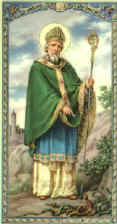

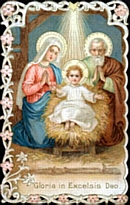
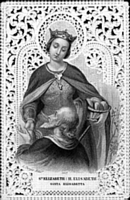
| They're a distinctive part of the Catholic "visual culture" --
inexpensive images that we use as bookmarks and keepsakes, tuck into picture
frames, slip inside Christmas and greeting cards, keep in our wallets, give
to our Godchildren and those we sponsor into the Church for their special
occasions... We keep ones with relevant prayers and images on them to hand
out to friends who are going through a hard time, and order special funeral
cards ("memorial cards") inscribed with the name and dates of birth and
death of the dead person. Nowadays, one can buy customized holy cards
inscribed with personal names and dates as keepsakes for Baptisms, First
Communions, Confirmations, etc. In Catholic culture, holy cards are
ubiquitous and have been for a long time. The earliest holy card -- a wood block print of St. Christopher -- dates to 1423. In that century, hand-cut and die-cut paper lace holy cards became extremely popular and were known as dévotesdentelles in France, and as Andachtsbilden in Germany. Modern holy cards developed when a German, Aloys Senefelder (1771-1834), developed lithography, an inexpensive way of multiplying graphics. In the 1840s, French companies in Paris in the area of the Church of St. Sulpice began mass-producing holy cards with designs characterized by soft and feminine-looking images, a style that became known as "St. Sulpice Art" ("l'art St. Sulpice"). While many of these cards were sold in America, other companies, such as Carl Benziger and Sons (later the Benziger Brothers), a Swiss company in operation since 1792, opened branches in America. Nowadays, the best and most commonly-seen holy cards are produced by the Bonella Brothers company, based in Milan, Italy. You can buy paper cards, laminated cards (they last much longer), cards imprinted with traditional art and icons, and tacky modern-looking cards. They generally cost between 30¢ and $2.00 and can be bought at most Catholic bookstores and giftshops. |
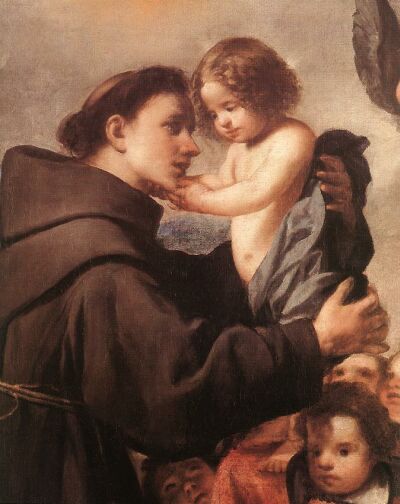
|
The
exorcizing proclamation is carried on the person or placed in homes. It is
also used in more specific situations, such as that encountered by the
French seamen who found their ship tossed by an angry sea during a storm off
Brittany's coast in 1708. One of the men wrote the words of St. Anthony's
Brief, and threw it into the sea with a prayer to the Saint. Immediately,
the seas calmed and the sailors were saved. |
| When a
material sacramental becomes so worn that it can no longer be used as a
sacramental, a Catholic won't casually toss it into the trash. To prevent
desecration, the sacramental should be returned to the earthly elements.
Holy water, for example, should be poured into a hole dug in the earth, in a
spot noone would walk over. Combustible sacramentals, such as scapulars and
holy books, should be burned and then buried. Larger sacramentals that don't
burn should be altered so that their form no longer appears to be a
sacramental (ex., a statue should be broken up into small pieces) and then
buried. Objects made of metals can be melted down and used for another
purpose. In the Sacristy (also called "Vestry") of a church -- the room where vestments, vessels and oils are stored, there is a special sink called a "sacrarium" (also "piscina") which is used for cleaning sacred vessels and getting rid of Holy Water, etc. This sink's drainage pipe doesn't lead to the sewer as do those of most sinks; instead, it goes directly to the earth so that liquid sacramentals, such as Holy Water and oils, and even the tiniest morsels of the Blessed Sacrament or drops of the Precious Blood which might be found on Patens or Chalices will be disposed of correctly and with reverence. Items lose their blessing or consecration if they are desecrated, or are substantially broken such that they can no longer be used for their sacred purpose, or if they are publicly sold (if an item is sold by one individual to another for only the price of the material itself -- i.e., if no profit is made, the blessing remains. E.g., if you were to give somone, say, a blessed rosary or sell it to him at cost, he would not have to have it re-blessed; if you sell a blessed rosary to someone for profit, he would need to take it to a priest.) Note that on 23 June -- the Eve of the Feast of St. John the Baptist -- it is custom to build large bonfires in which no longer useful material sacramentals are burned NOTE: Text and Imagery is courtesy of FISHEATERS.COM
|